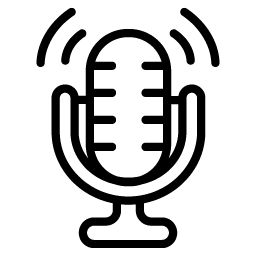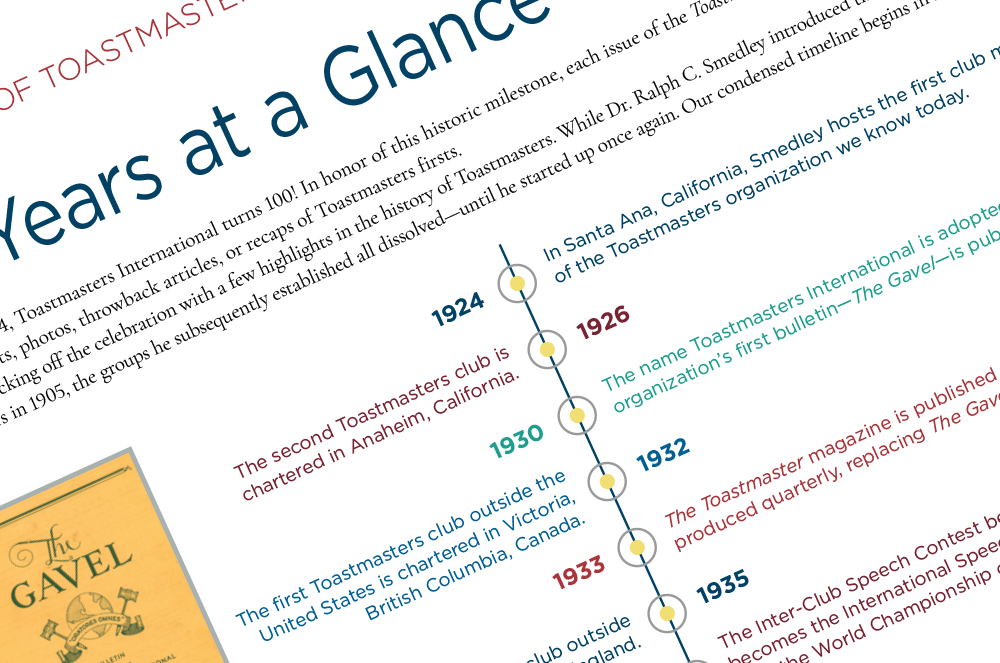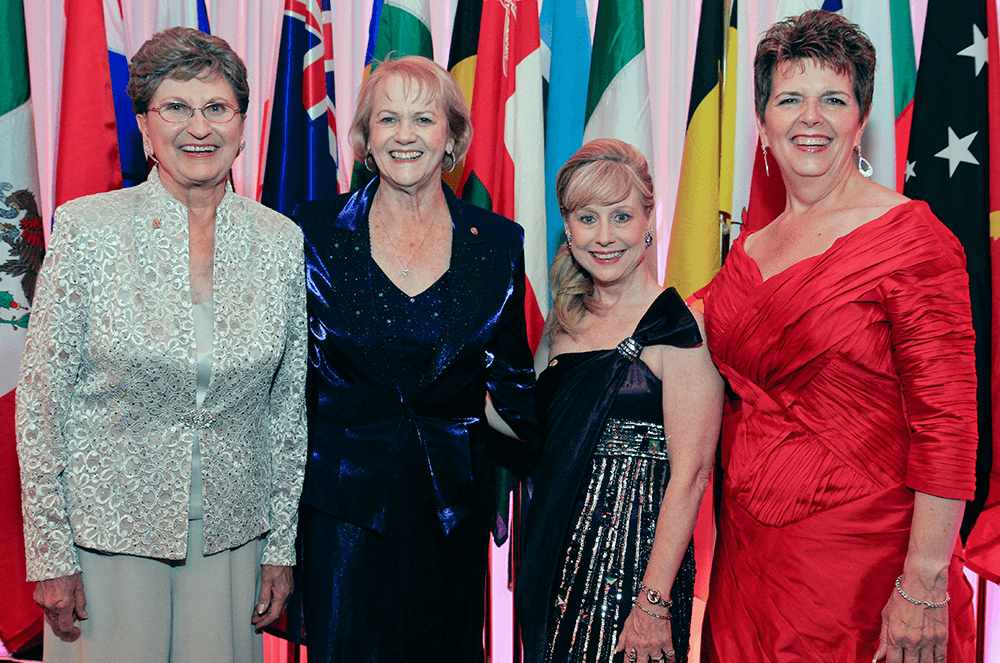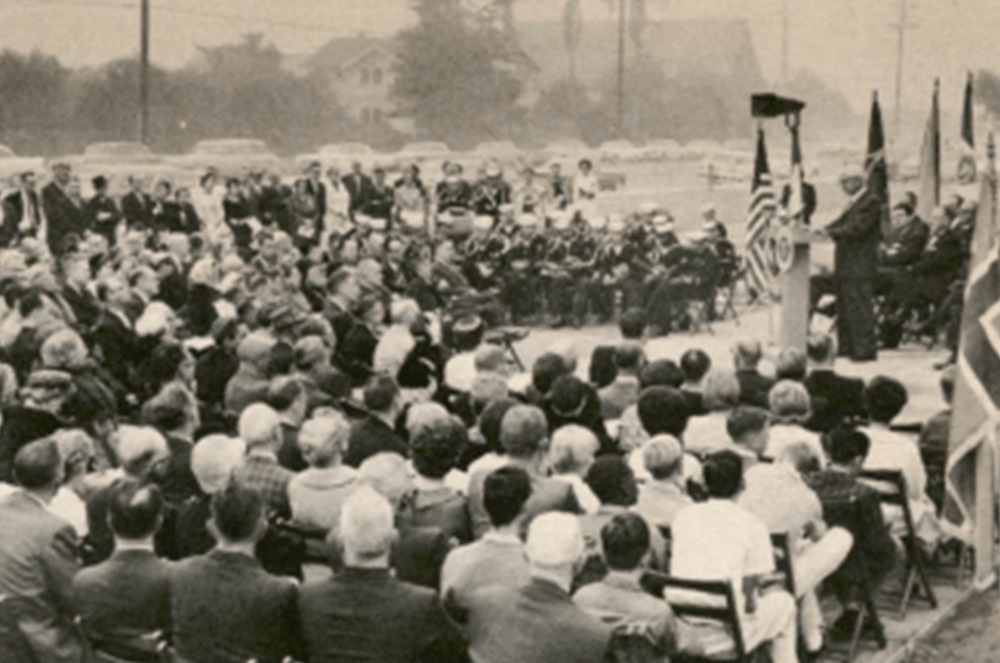Get out the cake, open the scrapbook, and start the speeches: Toastmasters International turns 100!
The centennial is a yearlong celebration, but the official anniversary is October 22. On that day in 1924, Ralph C. Smedley, a modest Midwesterner, led a meeting of about 25 men in the basement of a YMCA in Santa Ana, California, launching what would become the organization we know today. Millions of men and women have since benefited from the Toastmasters program.
Smedley’s goal was for individuals to become confident public speakers and leaders by practicing in a supportive group setting rather than a formal academic environment.
The concept was deliberately simple, and it has proved remarkably durable. Today, about 270,000 Toastmasters gather in more than 14,000 clubs. They meet in 150 countries.
The members, past and present, have shaped this history with their individual journeys of growth and learning.

Mark Brown, the International Convention announcer and 1995 World Champion of Public Speaking, says Toastmasters connects people of different nationalities and perspectives.
“This particular organization has changed my life, and I don’t think I’ll ever stop being a member,” says Mark Brown, a longtime Toastmaster in Macon, Georgia. The Jamaica native won Toastmasters’ 1995 World Championship of Public Speaking.
“I’ve become a better communicator, a better leader. But, I want to believe, also a better husband, a better father, and a better human being.”
Pat Johnson, DTM, 2010–2011 International President, first became a member in 1983.
“I joined Toastmasters because I was afraid to walk into a room. I was that shy and that lacking in confidence and self-esteem,” she says. “And I realized that I was a young woman of 30-something and I couldn’t speak.”
“People I know now can’t believe that I was like that,” adds the resident of Conquerall Mills, Nova Scotia, Canada. “But this is me, Toastmasters-transformed.”

It’s an exciting time for Toastmasters International as we celebrate the organization's centennial. To commemorate Toastmasters' 100th anniversary, Chief Executive Officer Daniel Rex is our special guest for a two-episode event.
Challenges and Change
The organization’s 100 years of existence is a testament to success and resilience. Toastmasters has met challenges (such as the World War II era and the COVID pandemic), adapted to societal and technology changes, and accommodated diverse member needs across the decades. The education program has evolved from a single pamphlet of tips from Ralph Smedley to an expansive digital learning program.
Toastmasters has grown from having a predominantly North America-based membership for many years to one that is now divided nearly equally between members from inside and outside North America. Women, who were not officially allowed to become members until 1973, today comprise more than 50% of the membership.

Consistent to Its Core
While the organization has evolved in many ways, it still hews closely to Smedley’s ideals. His mission and principles are throughlines in these 100 years, and they still form the core of what Toastmasters is: a global network of clubs where members learn to be dynamic communicators and leaders, fostering friendships in the process.
Smedley’s concept was brilliant “because every member has a home,” says Radhi Spear, DTM, Toastmasters’ 2024–2025 International President. “Their home is their club.”
Club meetings retain the same basic structure and purpose as in the organization’s early years. Now, like then, members prepare and deliver speeches, practice extemporaneous speaking (Table Topics®), and learn leadership and active listening by taking on meeting roles and speech evaluations.
Toastmasters Chief Executive Officer Daniel Rex, in his introduction to Confident Voices: The Story of Toastmasters, observes, “If Smedley were to sit in on a club meeting today, there are aspects he wouldn’t recognize, most notably the technology. However, despite all the external changes, there is no doubt he would recognize the agenda, the meeting roles, and the enthusiasm of the members.”
Men Only
Despite the common ground with the past, there are distinct differences today. Most obviously, the composition of the membership. For almost the first 50 years, members were all men. When Smedley started the organization, and for decades afterward, men were primarily the ones in the workforce, so the Toastmasters program was aimed at them. Women still had some options to be involved, though not at the same level. Clubs held “ladies nights” so members’ spouses could get a taste of Toastmasters. Husbands brought their wives to the International Convention, where fashion shows and shopping expeditions were organized for the women, while the men went about the business of self-improvement.
In the late 1930s, a group of women had formed an organization modeled on Toastmasters but existing independent of it, called International Toastmistress Clubs. The women identified themselves as “wives and sweethearts” of Toastmasters members. Smedley and other Toastmasters leaders offered their guidance to the parallel organization.
By the mid-1960s, Toastmasters clubs were allowed to form women’s auxiliary Toastmasters clubs if they desired. Some clubs also sponsored women as “honorary members”—allowed to attend club meetings but not eligible for awards or accepted as official members—and some women formed Gavel Clubs, open to those who didn’t qualify for regular club membership.

From left to right: Past International Presidents Helen Blanchard (1985–1986), Pauline Shirley (1994–1995), Jana Barnhill (2008–2009), and Pat Johnson (2010–2011)
Women Break Through
At the 1973 International Convention in Houston, Texas, delegates approved a new ruling that would allow women to officially become full members. The move was a boon to the organization: Ten years after the historic change, Toastmasters membership had doubled.
Helen Blanchard, DTM, was at the center of the shift. The trailblazing Toastmaster from San Diego, California, had surreptitiously become a member in 1970, disguising her gender to World Headquarters by using the name “Homer” Blanchard. After she became official, Blanchard kept batting away obstacles, becoming the first female International President in 1985.
Countless other women followed in her wake as leaders at all levels of the organization. “Helen laid the groundwork,” says Jana Barnhill, DTM, AS, 2008-2009 International President. “She is the one who paved our path.”
Fifty years after the Toastmasters ruling on women members, Morag Mathieson, DTM, of Bavaria, Germany, became the organization’s eighth female International President, while Radhi Spear, DTM, of Piscataway, New Jersey, and Aletta Rochat, DTM, of Cape Town, South Africa, were elected First and Second Vice President, respectively. Which meant that a woman would be the Toastmasters International President three years in a row.

Toastmasters across continental Europe celebrate in 2018 at the "Rebirth in Athens" conference in Greece. The event spotlighted years of membership growth, as two Districts reformed into six. Photo credit: Ana Isabel Ferreira
Growth Through the Years
The concept for a Toastmasters program actually began in 1905. Before Ralph Smedley came to Santa Ana, California, to lead operations at the new YMCA, he created Toastmasters clubs in several other cities where he worked for the Y. However, the clubs eventually disbanded each time he was transferred to another YMCA.
The pattern was broken in Santa Ana, and a new era began. From that single club in Santa Ana, Toastmasters would mushroom into a spate of other clubs in Southern California, then the western United States, and into places like Canada, Hawaii, and the United Kingdom. By 1945, a District had sprung up in Scotland.
Smedley was pleasantly surprised at the expansion. He realized, he said later, that Toastmasters “met a real need” for people.
The organization’s demographics changed, too, as more and more clubs emerged outside the U.S. and Canada. By the 1970s, clubs had chartered in South Africa, Australia, New Zealand, the Philippines, Mexico, Japan, and many other countries. In 1987, New Zealand’s John Fauvel, DTM, became the first International President from outside North America.
But with growth also came tensions. Members outside North America pushed for a bigger seat at the Toastmasters table. They wanted more equality among all Districts and opportunities for officer training, speech contests, and representation on the Board of Directors.
In 2009, delegates at the International Convention voted to change the organization’s global structure, resulting in Toastmasters regions existing outside North America for the first time. Under the new alignment, each of the 14 regions around the world would be represented by one International Director.
Toastmasters also created a translations department at World Headquarters, and with the help of member volunteers across the globe, translated Toastmasters materials and resources into a variety of languages.
Such diversity is symbolized by the annual Parade of Flags held at the International Convention. In a colorful display, members from around the world walk in a procession onstage, carrying the flags of their countries. As Toastmasters has built a presence in more and more countries, more and more flags have appeared.
Convention announcer Mark Brown narrates the event and says the parade is always an emotional sight.
“As I say the names of these different countries, and I realize we have Toastmasters cheering for these flags, some of the nations whose names I call may be at war, but their citizens are here with each other, at Toastmasters, because conflicts don’t matter to them,” Brown says.
“They know they can come here and build a personal relationship with somebody from that country.”
The Impact of Technology
Technology wielded its influence in various ways through the years. In the 1960s, television became a tool. The 1963 International Convention featured an education session that included demonstrations of modern television techniques, along with tips on how members could make use of the technology. Some Toastmasters clubs produced programs or segments on local public television.
In the 1980s, Toastmasters began producing audio and video content to supplement members’ learning. In the mid-1990s, the organization introduced a website.
In 2003, Toastmasters International went online to manage its administrative operations at World Headquarters in Southern California. The move was a catalyst for membership growth, especially outside the U.S., because membership payments and other transactions could now be processed easier and less expensively; previously, members primarily had to mail or fax their information.
The digital era ushered in more opportunities. Starting in 2011, members could access the Toastmaster magazine online. In 2017, the Pathways learning experience debuted with a digital education program. In the 2020s, many clubs began meeting online, and some now hold meetings in a hybrid format, with members attending both in person and online.
Member Achievements
There are many more strands to the Toastmasters story. Corporate clubs over the years have helped businesses benefit from the Toastmasters program, with employees in clubs boosting their communication and leadership skills. Speech contests, from club events to the World Championship of Public Speaking®, continue to be a highlight of the Toastmasters experience.
So, too, is the International Convention, an annual slate of education sessions, top speaking competitions, and social opportunities. The event has been held throughout the U.S. and in Canada, Malaysia, and The Bahamas.
Through the years, Toastmasters has expanded its training programs for club and District officers. Members have flourished as leaders in their communities, from the boardroom to the medical field, the political arena to the world of education. King Vidor, a famous director of Hollywood films in the 1940s and ‘50s, was a member of a club in Beverly Hills and spoke of how he benefited greatly from Toastmasters. As did Linda Lingle, governor of Hawaii from 2002 to 2010, and Philip Davis, DTM, elected prime minister of The Bahamas in 2021.
Generations of young people have developed self-confidence and speaking skills. Erica Alfaro, whose Mexican parents had worked in the agricultural fields of Southern California and urged her to pursue an education, shared how her Toastmasters club helped her prepare when she was chosen to give her college commencement address.

In Part 2 of Toastmasters 100, Chief Executive Officer Daniel Rex returns as our special guest. In this episode, he discusses the variety of resources and action items to help you explore, celebrate, and learn from the past 100 years of Toastmasters history. You'll also hear some enlivening personal stories.
The Next 100 Years
The world of Toastmasters keeps evolving—quite literally. In 2024, the organization charted a new global structure, reflecting increasing international growth. The alignment equally divides the 14 Toastmasters regions: seven inside North and South America, seven outside the Americas.
There are new opportunities for progress. The Pathways learning experience continues to be strengthened, hybrid club meetings offer the chance to improve online communication, and the Toastmasters alliance with Rotary International, which started in 2019, can help members positively impact others around the world.
“It’s the next hundred years that we should be concentrating on, as Dr. Smedley would have desired us to do,” says 2019–2020 International President Deepak Menon, DTM, of New Delhi, India.
The Toastmasters program, time-tested and universal, continues to meet a real need.
“I’m often asked, what is the role of Toastmasters in this age of digital communication?” muses Toastmasters CEO Daniel Rex. “Quite honestly, that makes me smile just a little bit. Human nature is human nature. Communication is as necessary now as it ever has been, maybe even more so.”
“Toastmasters,” he adds, “has a role in communication, now and in the future.”
Paul Sterman is senior editor, executive and editorial content, for Toastmasters International. Reach him at psterman@toastmasters.org.
Related Articles

Toastmasters History
100 Years at a Glance

News from Toastmasters
Women in Toastmasters Milestone

Toastmasters History



 Previous
Previous

 Previous Article
Previous Article